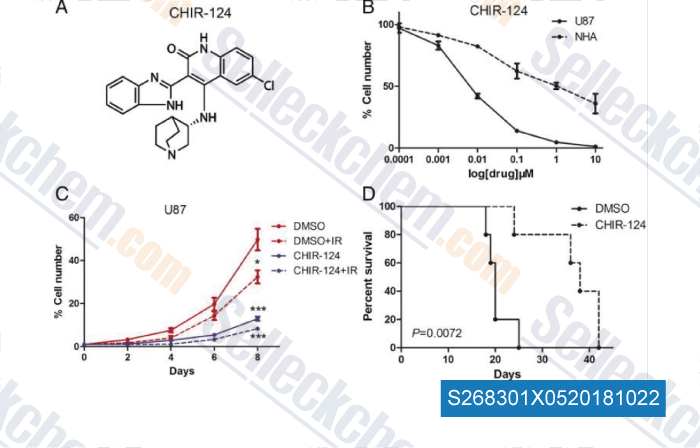|
Toll Free: (877) 796-6397 -- USA and Canada only -- |
Fax: +1-832-582-8590 Orders: +1-832-582-8158 |
Tech Support: +1-832-582-8158 Ext:3 Please provide your Order Number in the email. |
Technical Data
| Formula | C23H22ClN5O |
|||
| Molecular Weight | 419.91 | CAS No. | 405168-58-3 | |
| Solubility (25°C)* | In vitro | DMSO | Insoluble | |
| Water | Insoluble | |||
| Ethanol | Insoluble | |||
|
* <1 mg/ml means slightly soluble or insoluble. * Please note that Selleck tests the solubility of all compounds in-house, and the actual solubility may differ slightly from published values. This is normal and is due to slight batch-to-batch variations. * Room temperature shipping (Stability testing shows this product can be shipped without any cooling measures.) |
||||
Preparing Stock Solutions
Biological Activity
| Description | CHIR-124 is a novel and potent Chk1 inhibitor with IC50 of 0.3 nM in a cell-free assay. It shows 2,000-fold selectivity against Chk2, 500- to 5,000-fold less activity against CDK2/4 and Cdc2. | ||||||||
|---|---|---|---|---|---|---|---|---|---|
| Targets |
|
||||||||
| In vitro | CHIR-124 is a quinolone-based small molecule that is structurally unrelated to other known inhibitors of Chk1. CHIR-124 interacts synergistically with topoisomerase poisons (e.g., Camptothecin or SN-38) in causing growth inhibition in a variety of cancer cell lines, including breast carcinoma (MDA-MB-231 and MDA-MB-435) and colon carcinoma (SW-620 and Colo205), all of which contains the mutant p53 gene. CHIR-124 abrogates the SN-38-induced S and G2-M checkpoints and potentiates apoptosis in MDA-MD-435 breast cancer cells. The abrogation of the G2-Mcheckpoint and induction of apoptosis by CHIR-124 are enhanced by the loss of p53. [1] CHIR-124 also potently targets other kinases such as PDGFR and Flt3 with IC50 of 6.6 nM and 5.8 nM, respectively. [2] |
||||||||
| In vivo | CHIR-124 potentiates the growth inhibitory effects by abrogating the G2-M checkpoint and increasing tumor apoptosis in an orthotopic breast cancer xenograft model. |
Protocol (from reference)
| Kinase Assay: |
|
|---|---|
| Cell Assay: |
|
| Animal Study: |
|
References
|
Customer Product Validation

-
Data from [Oncotarget, 2014, 5(3), 667-78]

-
Data from [Data independently produced by , , J Pathol, 2015, 236: 348-359]

-
Data from [Data independently produced by , , J Virol, 2016, 90(20):9433-45]

-
Data from [Data independently produced by , , Transl Oncol, 2018, 11(1):140-146]
Selleck's CHIR-124 has been cited by 47 publications
| Enhancing transcription-replication conflict targets ecDNA-positive cancers [ Nature, 2024, 635(8037):210-218] | PubMed: 39506153 |
| The MYCN oncoprotein is an RNA-binding accessory factor of the nuclear exosome targeting complex [ Mol Cell, 2024, S1097-2765(24)00285-5] | PubMed: 38703770 |
| Replicative senescence is ATM driven, reversible, and accelerated by hyperactivation of ATM at normoxia [ bioRxiv, 2024, 2024.06.24.600514] | PubMed: 38979390 |
| p53-independent tumor suppression by cell-cycle arrest via CREB/ATF transcription factor OASIS [ Cell Rep, 2023, S2211-1247(23)00490-4] | PubMed: 37178686 |
| The MRN complex maintains the biliary-derived hepatocytes in liver regeneration through ATR-Chk1 pathway [ NPJ Regen Med, 2023, 8(1):20] | PubMed: 37024481 |
| The MRN complex maintains the biliary-derived hepatocytes in liver regeneration through ATR-Chk1 pathway [ npj Regenerative Medicine, 2023, 20-2023)] | PubMed: None |
| Alternative Lengthening of Telomeres in Pediatric High-Grade Glioma and Therapeutic Implications [ Cancers (Basel), 2023, 15(12)3070] | PubMed: 37370681 |
| Alternative Lengthening of Telomeres in Pediatric High-Grade Glioma and Therapeutic Implications [ Cancers (Basel), 2023, 15(12)3070] | PubMed: 37370681 |
| The Autonomous Parvovirus Minute Virus of Mice Localizes to Cellular Sites of DNA Damage Using ATR Signaling [ Viruses, 2023, 15(6)1243] | PubMed: 37376543 |
| The Autonomous Parvovirus Minute Virus of Mice Localizes to Cellular Sites of DNA Damage Using ATR Signaling [ Viruses, 2023, 15(6)1243] | PubMed: 37376543 |
RETURN POLICY
Selleck Chemical’s Unconditional Return Policy ensures a smooth online shopping experience for our customers. If you are in any way unsatisfied with your purchase, you may return any item(s) within 7 days of receiving it. In the event of product quality issues, either protocol related or product related problems, you may return any item(s) within 365 days from the original purchase date. Please follow the instructions below when returning products.
SHIPPING AND STORAGE
Selleck products are transported at room temperature. If you receive the product at room temperature, please rest assured, the Selleck Quality Inspection Department has conducted experiments to verify that the normal temperature placement of one month will not affect the biological activity of powder products. After collecting, please store the product according to the requirements described in the datasheet. Most Selleck products are stable under the recommended conditions.
NOT FOR HUMAN, VETERINARY DIAGNOSTIC OR THERAPEUTIC USE.
